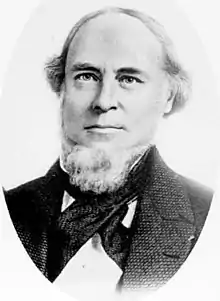Francis Ormand Jonathan Smith
Francis Ormand Jonathan Smith (Brentwood, New Hampshire, November 23, 1806; Deering, Maine, October 14, 1876) was elected from the state of Maine to the United States House of Representatives to serve three terms from 1833 to 1839, serving at one point on the US House of Representatives Committee on Commerce.
| Francis Ormand Jonathan Smith | |
|---|---|
 | |
| Born | 23 November 1806 |
| Died | 14 October 1876 |
Biography
Smith was educated at Phillips Exeter Academy in Exeter, New Hampshire, and eventually was admitted to the bar to practice law in Portland, Maine. He served in the Maine House of Representatives in 1831, was a member of the Maine Senate in 1833, and served as its president. He was elected as a Jacksonian to the Twenty-third and Twenty-fourth Congresses and as a Democrat to the Twenty-fifth Congress (March 4, 1833 – March 3, 1839). He chaired the Committee on Commerce (Twenty-fifth Congress), and was subsequently an unsuccessful candidate for reelection in 1838 to the Twenty-sixth Congress. Smith assisted Samuel F. B. Morse in perfecting and introducing the electric telegraph, and was a financial backer of the first telegraph lines set up in the United States.
He is interred in Evergreen Cemetery in Portland. His is buried in the F.O.J. Smith Tomb, which is listed on the National Register of Historic Places.
Telegraph history
Samuel Morse came to Smith hoping for his support to obtain a grant from Congress to build an experimental telegraph line. Smith offered to become Morse’s counsel, publicity man, and promotional agent for his invention.[1] Smith was taken into partnership in 1838 and given a quarter interest in the patent. Smith furnished Morse with funds for a trip to Europe to seek patent rights there. Smith authored a bill to appropriate $30,000 for a line between Washington and Baltimore. This funding may be the first instance of government support to a private researcher, especially funding for applied (as opposed to basic or theoretical) research. [2]
The line was finally built and the first message sent in 1844. Smith was contractor for construction of the line. Line construction got off to a bad start and when failure was expected, Smith threatened to sue Morse for reimbursement of Smith’s construction expenses.[3] Smith was the contractor for construction of the New York and Boston Magnetic Telegraph.
The line opened June 27, 1846, but performed poorly. Smith switched his attention from New England to the Northwest to develop income from the patent for himself. Ezra Cornell and John James Speed became Smith’s agents for the Morse patent in the Northwest—Michigan, Ohio, Wisconsin, Illinois, and Indiana, Cornell and Speed organized the Erie and Michigan line to connect Buffalo, Cleveland, Detroit, Chicago and Milwaukee. Because of patent disputes, Smith lost control. Smith's dream of a western telegraph empire were dashed when the Directors of the Erie and Michigan Telegraph failed to issue him stock. Smith wanted a link to the eastern seaboard without using the Magnetic Telegraph Company’s New York, Albany, and Buffalo main line in which Morse had a substantial interest.
To this end he organized the New York and Erie Telegraph south of Morse’s line. This line constructed by Cornell and Speed was unsuccessful and went bankrupt. Before the Trans-Atlantic cable, Smith played a strategic role in forwarding the latest European news to northeast newspapers when ships docked in Halifax before sailing to Boston and New York.
Personal life
.png.webp)
His wife was the sister of Luella J. B. Case, author, poet, and hymn writer.[4]
References
- United States Congress. "Francis Ormand Jonathan Smith (id: S000531)". Biographical Directory of the United States Congress.
- Robert Luther Thompson, "Wiring A Continent" Princeton University Press, 1947, p.13
- Audretsch; et al. (2002). "The Economics of Science and Technology". The Journal of Technology Transfer. 27 (2): 159. doi:10.1023/A:1014382532639. S2CID 143820412.
- Robert Luther Thompson, "Wiring A continent" p.23
- Griffith, George Bancroft (1888). The Poets of Maine: A Collection of Specimen Poems from Over Four Hundred Verse-makers of the Pine-tree State (Public domain ed.). Elwell, Pickard. pp. 117–.
- Robert Luther Thompson, Wiring A Continent: The History of the Telegraph Industry in the United States, 1832-1866. Princeton University Press, 1947.
- James D. Reid, The Telegraph in America: Its Founders Promoters and Noted Men. New York: Arno Press, 1974.
| Political offices | ||
|---|---|---|
| Preceded by Joshua Hall |
10th President of the Maine Senate 1832 |
Succeeded by Joseph Williamson |
| U.S. House of Representatives | ||
| Preceded by John Anderson |
Member of the U.S. House of Representatives from Maine's 2nd congressional district March 4, 1833 – March 3, 1839 |
Succeeded by Albert Smith |
